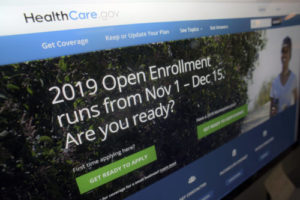Georgia’s uninsured rate rose slightly in 2018, to 13.7 percent, the U.S. Census Bureau reported Tuesday.
That gives Georgia the nation’s third-highest rate of people without health insurance. The state trails only Texas and Oklahoma.

Georgia had the fourth-highest percentage in 2017.
The national uninsured rate also rose in 2018, from 7.9 percent of Americans, or 25.6 million, to 8.5 percent, or 27.5 million, the Census Bureau said.
The Georgia increase is small enough not to be statistically significant, said Bill Custer, a health insurance expert at Georgia State University. But he added, “We’ve lost ground to other states’’ whose uninsured rates have dropped in recent years.
Such negative numbers have prompted the state’s political leadership to seek action.
Gov. Brian Kemp successfully pushed legislation this year to pursue two waiver proposals, seeking federal permission to enact insurance changes in the state. One of the waivers would involve potentially adding members to the state’s Medicaid program.
The state law authorizing the waiver effort outlines a possible Medicaid change of including people up to 100 percent of the federal poverty level. That’s in contrast with the standard Medicaid expansion level of up to 138 percent of poverty. Georgia is one of 14 states (including Texas and Oklahoma) that have not expanded Medicaid under the Affordable Care Act (ACA).
Unlike the slight change in the Georgia rate, the national increase in uninsured is significant, Custer said. “There is no underlying economic reason to see an increase in uninsured,’’ he said. Typically, when the economy has a poor year, the number of people without health coverage tends to rise as more workers lose jobs. The economy, however, has been strong recently.

The rise in uninsured last year “is driven by policy,” Custer said. But he added, “It’s difficult to pinpoint a single policy.’’
Health care advocates have complained that efforts by the Trump administration and Congress are jeopardizing insurance enrollment, Kaiser Health News reported.

Custer pointed to several possible factors in the rise in the uninsured rate. They include cuts in federal funding to publicize the ACA’s health insurance exchanges, which offer a way for low-income people to buy coverage. The feds have also cut funding for special counselors, or “navigators,” who assist people in using the exchanges.
He also cited the abolition by Congress of the ACA’s tax penalty for people who don’t have health coverage. That could make more people willing to take a chance on doing without it.
The rise in uninsured was the first increase since the ACA took full effect in 2014, the New York Times reported.
The Census report, meanwhile, showed the percentage of Americans living in poverty fell to 11.8 percent, the lowest level since 2001.

After decades of rising inequality, recent wage gains have been strongest for people at the bottom of the earnings ladder, said Michael R. Strain, an economist at the American Enterprise Institute, according to the Times. “You’re seeing improvements in employment outcomes for people with disabilities. You’re seeing improvements in employment outcomes for the formerly incarcerated.”
Among the notable features of the insurance data is the percentage of uninsured children under the age of 19 increasing by 0.6 percentage points from 2017 to 2018, to 5.5 percent. The Census Bureau said the increase occurred largely because of a decline in public coverage.
Joan Alker, executive director of the Georgetown University Center for Children and Families, said in a statement Tuesday that the data “confirm our worst fears. An estimated 425,000 more children were uninsured nationwide in 2018.’’

“This serious erosion of child health coverage is due in large part to the Trump administration’s actions that have made health coverage harder to access and have deterred families from enrolling their eligible children in Medicaid and CHIP. The share of children in employer-sponsored insurance remained the same, indicating that the strong economy isn’t compensating for children losing Medicaid/CHIP coverage.’’
Children hit hardest by coverage losses include Latino children, non-Hispanic white children and children under age 6, Alker said.
“When children don’t have health coverage, their health care needs are less likely to be met,’’ she said. “It is especially troubling that young children are losing coverage. A child’s brain develops rapidly in the earliest years of life, building a foundation for future educational and economic success.’’
Polly McKinney of the advocacy group Voices for Georgia’s Children said that “sometimes state-level practice and policy can create obstacles for enrolling children. Cumbersome forms, poor communication between parties and government bureaucracy are all contributing factors.’’ (Here’s a recent GHN article about state policy on children’s insurance.)
“We are hopeful that with the current attention on health care access across the state by the Legislature and administration that these barriers can be mitigated or, even better, completely eliminated,’’ McKinney said. “It’s important to remember that costs to the state and society are greatly reduced when kids can get the health care they need and deserve in a timely fashion.’’
The Census Bureau also reported that in 2018, private health insurance coverage continued to be more prevalent nationally than public coverage, covering 67.3 percent of the population and 34.4 percent of the population, respectively. Employer-based insurance remained the most common, covering 55.1 percent of the population for all or part of the calendar year.
And between 2017 and 2018, the percentage of people covered by Medicaid decreased by 0.7 percentage points to 17.9 percent. The rate of Medicare coverage increased by 0.4 percentage points.

